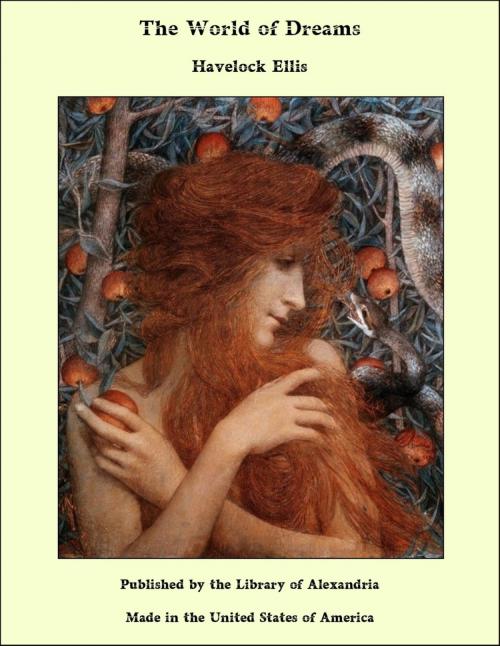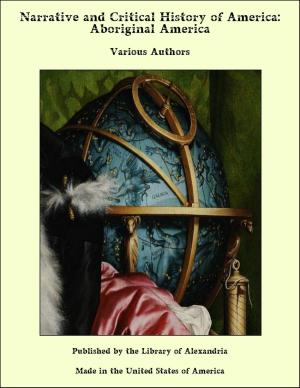| Author: | Havelock Ellis | ISBN: | 9781465626523 |
| Publisher: | Library of Alexandria | Publication: | March 8, 2015 |
| Imprint: | Language: | English |
| Author: | Havelock Ellis |
| ISBN: | 9781465626523 |
| Publisher: | Library of Alexandria |
| Publication: | March 8, 2015 |
| Imprint: | |
| Language: | English |
There are at least four different ways of writing a book on dreams. There is, for instance, the literarymethod. In this way one goes to books or to the memories of other people for one's material, and so collects a great number of more or less wonderful stories. I have rejected this method, for it is entirely untrustworthy. Dreams are elusive at the best; only a very careful observer can set down a dream faithfully, even directly after it has occurred, and no one can safely entrust a dream to memory. There is, again, what I may call the clinical method of studying dreams by the personal observation and collection of facts, with summation and analysis of the results. On a large scale, with the aid of thequestionnaire, this method has been especially carried on in the United States, notably at Clark University under the inspiration of Dr. Stanley Hall. A strict and scientific adherence to the clinical method of studying dreams has resulted in Professor Sante de Sanctis's book I Sogni (first edition 1899), which is, on the whole, the best book on dreams published in recent years. Then there is the experimental method, which, not content with mere objective study of the phenomena, endeavours to interfere with them and to find out the results of interference. This method may be combined with other methods of studying dreams. In its pure form it has in recent years been especially practised by the late Mourly Vold. Its results are not without interest, but they do not cover a large part of the field, and they are not altogether reliable. Dreaming activity is so fluid and suggestible—and this is notably so when experimenter and subject are the same person—that interference with the phenomena deforms them, and we cannot be sure that by experiment we have really learned much about the life of dreams. There is, finally, the introspective method. This may be said to be the earliest of the more scientific methods of studying dreams. Maine de Biran was here a pioneer, and Maury, in his famous book, Le Sommeil et les Rêves (1861), which inaugurated the modern study of dreams, adopted a mainly introspective method, though he was not always quite successful in avoiding the fallacies of that method. It is in France that this method has been most frequently and most successfully cultivated. Professor Sigmund Freud's Die Traumdeutung (first edition, 1900), may be said to belong to the introspective class, though to a special division which Freud himself terms psycho-analytic. This is undoubtedly the most original, the most daring, the most challenging of recent books on dreams, and is now the text-book of a whole school of investigators. It is not a book to be neglected, for it is written by one of the profoundest of living investigators into the obscure depths of the human soul. Even if one rejects Freud's methods as unsatisfactory and his facts as unproved, the work of one so bold and so sincere cannot fail to be helpful and stimulating in the highest degree. If it is not the truth it will at least help us to reach the truth.
There are at least four different ways of writing a book on dreams. There is, for instance, the literarymethod. In this way one goes to books or to the memories of other people for one's material, and so collects a great number of more or less wonderful stories. I have rejected this method, for it is entirely untrustworthy. Dreams are elusive at the best; only a very careful observer can set down a dream faithfully, even directly after it has occurred, and no one can safely entrust a dream to memory. There is, again, what I may call the clinical method of studying dreams by the personal observation and collection of facts, with summation and analysis of the results. On a large scale, with the aid of thequestionnaire, this method has been especially carried on in the United States, notably at Clark University under the inspiration of Dr. Stanley Hall. A strict and scientific adherence to the clinical method of studying dreams has resulted in Professor Sante de Sanctis's book I Sogni (first edition 1899), which is, on the whole, the best book on dreams published in recent years. Then there is the experimental method, which, not content with mere objective study of the phenomena, endeavours to interfere with them and to find out the results of interference. This method may be combined with other methods of studying dreams. In its pure form it has in recent years been especially practised by the late Mourly Vold. Its results are not without interest, but they do not cover a large part of the field, and they are not altogether reliable. Dreaming activity is so fluid and suggestible—and this is notably so when experimenter and subject are the same person—that interference with the phenomena deforms them, and we cannot be sure that by experiment we have really learned much about the life of dreams. There is, finally, the introspective method. This may be said to be the earliest of the more scientific methods of studying dreams. Maine de Biran was here a pioneer, and Maury, in his famous book, Le Sommeil et les Rêves (1861), which inaugurated the modern study of dreams, adopted a mainly introspective method, though he was not always quite successful in avoiding the fallacies of that method. It is in France that this method has been most frequently and most successfully cultivated. Professor Sigmund Freud's Die Traumdeutung (first edition, 1900), may be said to belong to the introspective class, though to a special division which Freud himself terms psycho-analytic. This is undoubtedly the most original, the most daring, the most challenging of recent books on dreams, and is now the text-book of a whole school of investigators. It is not a book to be neglected, for it is written by one of the profoundest of living investigators into the obscure depths of the human soul. Even if one rejects Freud's methods as unsatisfactory and his facts as unproved, the work of one so bold and so sincere cannot fail to be helpful and stimulating in the highest degree. If it is not the truth it will at least help us to reach the truth.















